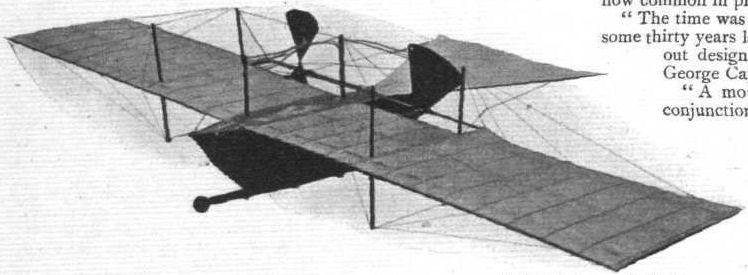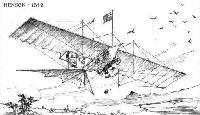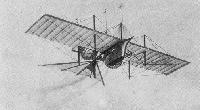M.Goodall, A.Tagg British Aircraft before the Great War (Schiffer)
Deleted by request of (c)Schiffer Publishing
HENSON monoplane (William Samuel Henson, Chard, Somerset)
W.S. Henson was an inventor who began experimenting in 1840 with model gliders, and in 1842, his patent No.9478 described a monoplane of advanced conception, to be powered by a steam engine, from which 25-30hp was expected. Earlier, he had become acquainted with John Stringfellow, a fellow inventor and designer of machinery, including light steam engines for driving lace making machines. It is believed that Stringfellow contributed his knowledge to further the design of the aeroplane.
From 1843 Henson and Stringfellow experimented with various steam powered models, with wing span up to 20ft, near Chard. In association with others, a company known as 'The Aerial Steam Transit Co.' was formed in 1844. There was considerable publicity, but the project was premature and collapsed. Henson finally withdrew from aeronautical work and emigrated to America in 1848, but Stringfellow worked on after 1848 achieving short flights with small models. His interest revived in 1866, and he won a prize of ?100 at the Crystal Palace for a successful flight. Stringfellow died in 1883 and certain of his models are exhibited at the Science Museum. Henson died in 1888 at Newark, New Jersey, U.S.A.
The proposed Henson aeroplane was to be a large monoplane, with passengers housed in a cabin below the wing, and was mounted on a tricycle undercarriage. The machine was to be launched down an incline and then propelled by two six bladed propellers driven by belts from the engine, which with its large boilers was positioned above the cabin.
Power: 25-30hp Stringfellow two-cylinder steam engine.
Data
Span 150ft
Chord 30ft
Wing area 4,500 sq ft
Tail area 1,500 sqft
Показать полностью
Журнал Flight
Flight, April 24, 1909.
A CENTURY AGO.
SIR GEORGE CAYLEY ON FLIGHT IN 1809.
AMONG the models exhibited at Olympia was, as we mentioned in last week's issue, one which the Aero Club had had constructed as a copy of the Henson-Stringfellow model in the South Kensington Museum. Appended to the model was the following very interesting notice, which not only describes an inventor's ideas of a hundred years ago, but also pays fitting tribute to Sir George Cayley who, of all early scientists, made perhaps the most profound study of flight, thereby enrolling his name in this country honourably in the list of those who first extended their mental vision to include the conquest of the air within the boundaries of science : -
"This year, 1909, is the centenary of the appearance in Nicholson's Journal and the Philosophical Magazine of some remarkably able articles on flight by an English scientist, Sir George Cayley. His insight into the problem of aviation was profound, but neither his own generation nor his successors realised his merit, for he was so much in advance of his time that it has needed an interval of a hundred years to demonstrate the truth of his assertions.
"France has not hesitated to do him justice, and M. Tatin, writing in the Elements d1 Aviation, has said : -
"'It would be difficult to construct a machine to-day which did not embody the majority of the features indicated by Cayley. His contributions to the theory of flight form a work of reference which it is well not to ignore.'
"Much earlier, in 1874, another Frenchman, M. Penaud - himself well known as a pioneer in flight - paid a special visit to England on purpose to make research among Cayley's writings, and on his return to France he presented his discoveries in eulogistic terms before a meeting of the Societe Francaise de Navigation Aerienne.
"Sir George Cayley seems to have appreciated almost every side of the problem of aerial navigation. He foresaw the difficulties associated with dirigible balloons on account of their enormous size, but he pointed out how they might be made to ascend and descend in the air without loss of ballast.
"In 1796 he constructed a model helicopter with a pair of lifting screws revolving in opposite directions, and expressed his conviction that it would be possible for a full-sized man-lifting machine to be made on these lines. He anticipated the advent of aeroplanes, and, knowing that great lifting effect could be obtained from surfaces moving through the air at slight inclinations to the horizontal, he pointed out the importance of carrying out what are now known as 'lift and drift' experiments. He suggested the use of a tail as a means of obtaining automatic longitudinal stability in aeroplanes, and he further showed how the pivoting of that tail would enable it to be used as an elevator for ascent and descent. He deduced the advantage of wing flexion from his observations of bird flight, and he carried his investigations on the subject of propulsion into a close study of the theory of screws. Having invented a hot-air engine - and that, probably, the first of its kind - he foresaw possibilities in the use of gaseous mixtures, which have since been more than realised in the development of the petrol engine. On the question of steam he was even more precise, for he definitely suggested the use of a tubular boiler and surface condenser, both of which principles are now common in practice.
"The time was not then ripe for the realisation of his ideas, but some thirty years later, in 1843, an engineer named Henson drew out designs for a steam-driven monoplane based on Sir George Cayley's data.
"A model of Henson's machine, which he constructed in conjunction with Stringfellow, is on exhibition at the South Kensington Museum, and it is a copy of this model, on a smaller scale, which is on view above. The design was patented in 1842, and is thus officially described in the Museum: -
"'The model consists of an extended surface or aeroplane of oiled silk, or canvas stretched upon a bamboo frame made rigid by trussing, both above and below. A car is attached to the under side of the aeroplane to contain the steam engine, passengers, &c. It has three wheels to run freely upon when it reaches earth. Two propellers, 3 ft. in diameter, are shown with their blades, set at 45 degs. They are operated by endless cords from the engine. Behind these is a fan-shaped tail stretched upon a triangular frame capable of being opened out, closed, or moved up and down by means of cords and pulleys. By this latter arrangement ascent or descent was to be accomplished. A rudder for steering sideways is placed under the tail, and above the main aeroplane a sail (not shown) was to be stretched between two masts rising from the car, to assist in maintaining the course. When in motion the front edge of the machine was to be raised in order to obtain the required air support. To start the model it was proposed to allow it to run down an incline, e.g., the side of an hill, the propellers being first set in motion. The velocity gained in the descent was expected to sustain it in its further progress, the engine overcoming the head resistance when in full flight. Experiments were eventually made on the downs near Chard, and the night trials were abandoned, as the silk became saturated from a deposit of dew. After many day trials, down wide inclined rails, the model was found to be deficient in stable equilibrium for open-air experiments, little puffs of wind or ground currents being sufficient to destroy the balance. The actual machine was never constructed, but in 1847-8 F. Stringfellow built a model which is supposed to be the first flying machine to perform a successful flight.
"'The dimensions of the model shown are 20 ft. from tip to tip of wings, by 3 '5 ft. wide, giving 70 sq. ft. sustaining surface to the wings, and about 10 sq. ft. in the tail. Its weight is about 25 lbs. The actual machine was to weigh about 3,000 lbs., with 4,500 sq. ft. surface in the wings, and 1,500 sq. ft. in the tail."'
Flight, January 21, 1911
F. J. STRINGFELLOW.
THE death of Mr. F. J. Stringfellow, son of the famous J. Stringfellow, which occurred at Bristol on New Year's Day, is the breaking of yet another direct link with the very foundation of the science of flight in this country, for it was his father who made the first successful power-driven model, which demonstrated the phenomenon of dynamic flight for the first time, in 1848.
Previously, J. Stringfellow was associated with W. S. Henson, and together they produced a model, which was not successful on trial, but is perhaps the best known of all early ideas in flying machines. It is the subject of many curious old prints, and it is rather a coincidence that we should have just received from the Rev. Sidney Swann an excellent photograph of an old printed handkerchief belonging to Mrs. Mackintosh, of Edinburgh, showing a cartoon illustration in which the Henson and Stringfellow model is the central figure. A reproduction of this photograph appears on this page, and one of the most remarkable features of the machine is the trussing of the main planes in a manner identical with that of the Antoinette monoplane of the present day. Indeed, the machine as a whole might have been a copy, rather than the prototype, of the modern monoplane.
J. Stringfellow's successful model was designed on similar lines, but was even more closely in accord with modern principles. F. J. Stringfellow, son of J. Stringfellow, carried on his father's work and built a biplane model, but he was unable to properly complete his experiments. Quite apart from the interest associated with the construction of the models as flying machines, it is equally important to remember that the Stringfellows showed remarkable ability in the making of small engines, which is quite a problem in itself and has exercised the minds of many other flight pioneers. We also reproduce on this page a portrait of the late J. Stringfellow, kindly sent us by Mrs. F. J. Stringfellow, with whom, in her present trouble, our readers will, we feel sure, join us in an expression of sympathy. All the machinery of his father's models Mr. F. J. Stringfellow has bequeathed to his youngest son, Mr. E. Stringfellow.
Flight, July 5, 1913.
THE PIONEERS.
<...>
Sir George Cayley's influence was considerable, and undoubtedly coloured the work of many who came after him. Those who next appear in chronological sequence among historical pioneers were Henson and Stringfellow, both sometime residents of Chard, in Somersetshire. They worked together on the building of large models, which they tried to make fly by means of small and very ingeniously constructed steam-engines. Ultimately Stringfellow succeeded in producing a monoplane which was self-supporting by the aid of its own power plant, and with this he made a public demonstration in 1848. It was the first time that any sort of aeroplane had ever been built to sustain itself aerodynamically, but the significance of the accomplishment was apparently quite unrecognised by those who witnessed the demonstration at that time. On the other hand, there is a curious old print of the same date that depicts with the liveliest imagination a monoplane on its way to China or some other similarly far-distant locality.
<...>
Показать полностью










